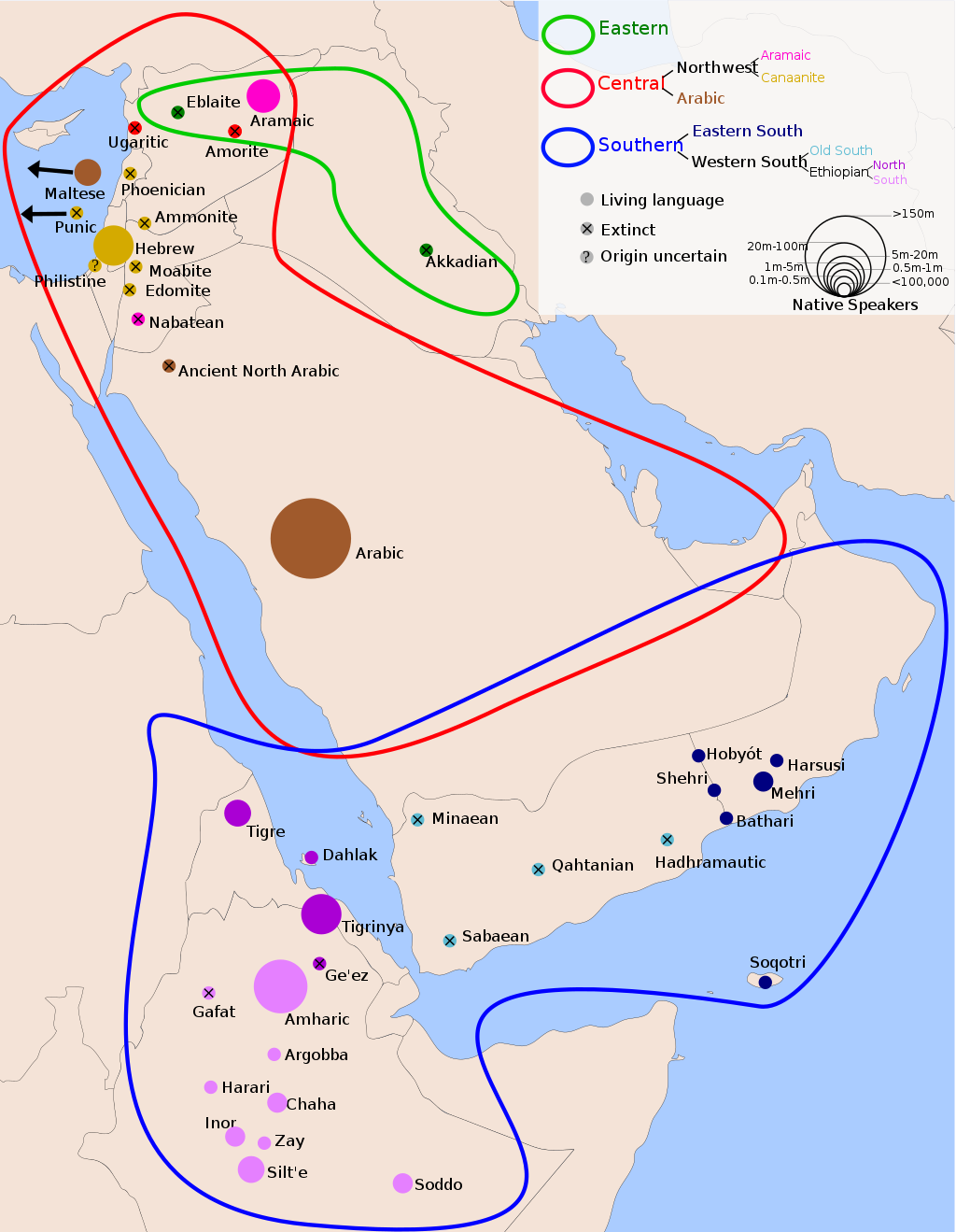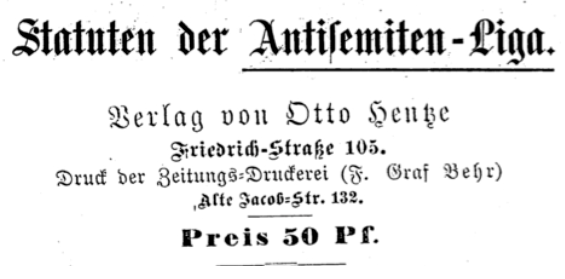

セム族
Semites
The first depiction of historical ethnology
of the world separated into the biblical sons of Noah: Semites, Hamites
and Japhetites. Gatterer's Einleitung in die Synchronistische
Universalhistorie (1771) explains his view that modern history has
shown the truth of the biblical prediction of Japhetite supremacy
(Genesis 9:25–27).//
Distribution of Semitic languages.
☆セ
ム族(セムぞく、英:
Semites)は、セム系の言語を使用する人々の総称である[1]。中東、西アジアや北アフリカ、アラビア半島に分布する古代・現代のさまざまなセム語
の話手を指し、アッカド人、古代アッシリア人、バビロニア人、エブラ人、ウガリット人、カナン人、フェニキア人(カルタゴ人を含む)、ヘブライ人(イスラ
エル人、ユダヤ人、サマリア人)、アラム人、カルデア人、アムル人、モアブ人、エドム人、ヒクソス、ナバタイ人、サバ人、マルタ人、マンダ教徒、サービア
教徒、シリア人、アマレク人、アラブ人、アッシリア人、パルミラ人、ケダル人などを含む。セムという名称は当初、アウグスト・ルートヴィヒ・フォン・シュ
レーツァーがヨーハン・ゴットフリート・アイヒホルン(英語版)の
"Repertorium"(1781年)において、ヘブライ語に関連する語群を指す用語として提起したものであった[2]。アイヒホルンを通じてこの名
称は一般的に使用されるようになった。以来、セム語の話者の集団のみならず、明らかにセム人にルーツがあるとみられる人々や、歴史の中で完全にセム化した
と考えられる民族集団もいくぶん広い意味でセム人に含めることもあった。セムという名称は比較言語学において語族名に転用され、セム語族(英:
Semitic Language Family)という用語が生まれた。その上位にはセム・ハム語族 (Semito-Hamitic)
ないしハム・セム語族 (Hamito-Semitic)、後にはアフロ・アジア語族 (Afro-Asiatic)
が立てられ[6]、セム諸語(英: Semitic Languages)はその下位グループとされた。今日では Semitic
をセム語派と翻訳することもあるが、セム語族という呼称も用いられる。反セム主義 (anti-Semitism, antisemitism)
という語は、その文字通りの意味ではなく、反ユダヤ主義に限って使われるが、19世紀にエルネスト・ルナンやヴィルヘルム・マルなどによってセム族とアー
リア族が対比され、反ユダヤ主義を「反セム主義」とする呼称が使われるようになり、定着した(→https://x.gd/0AJUh)。
| Semites, Semitic peoples or Semitic
cultures is an obsolete term for an ethnic, cultural or racial
group.[2][3][4][5] The terminology is now largely unused outside the
grouping "Semitic languages" in linguistics.[6][7][8] First used in the
1770s by members of the Göttingen School of History, this biblical
terminology for race was derived from Shem (Hebrew: שֵׁם), one of the
three sons of Noah in the Book of Genesis,[9] together with the
parallel terms Hamites and Japhetites. In archaeology, the term is sometimes used informally as "a kind of shorthand" for ancient Semitic-speaking peoples.[8] Ethnicity and race Further information: Afroasiatic Urheimat, Proto-Semitic language § Urheimat, Hamites, and Scientific racism  This T and O map, 1472, from the first printed version of Isidore of Seville's Etymologiae, identifies the three known continents as populated by descendants of Sem (Shem), Iafeth (Japheth) and Cham (Ham). The term Semitic in a racial sense was coined by members of the Göttingen School of History in the early 1770s. Other members of the Göttingen School of History coined the separate term Caucasian in the 1780s. These terms were used and developed by numerous other scholars over the next century. In the early 20th century, the pseudo-scientific classifications of Carleton S. Coon included the Semitic peoples in the Caucasian race, as similar in appearance to the Indo-European, Northwest Caucasian, and Kartvelian-speaking peoples.[10] Due to the interweaving of language studies and cultural studies, the term also came to be applied to the religions (ancient Semitic and Abrahamic) and ethnicities of various cultures associated by geographic and linguistic distribution.[11] |
Semite, Semitic peoples or
Semitic
cultures(セム人、セム民族、セム文化)は、民族的、文化的、または人種的グループのための時代遅れの用語である[2][3][4][5]。
この用語は、言語学における「セム語」というグループ以外では、現在ではほとんど使われていない。
[6][7][8]1770年代にゲッティンゲン学派のメンバーによって初めて使用されたこの聖書の人種用語は、『創世記』に登場するノアの3人の息子の
1人であるセム(ヘブライ語:שם)に由来し[9]、並列用語であるハム人(Hamites)やヤフェット人(Japhetites)と共に使用された。 考古学では、この用語は古代のセム語を話す民族の「一種の略語」として非公式に使われることもある[8]。 民族と人種 さらに詳しく: アフロアシア語族ウルヘイマット、原セム語族言語§ウルヘイマット、ハム人、科学的人種主義  1472年、セビリアのイシドール著『Etymologiae』の最初の印刷版に掲載されたこのTとOの地図は、セム(セム)、イアフェト(ヤフェト)、 チャム(ハム)の子孫が住む3つの大陸を特定している。 人種的な意味でのセム人という言葉は、1770年代初頭にゲッティンゲン学派のメンバーによって作られた。ゲッティンゲン学派の他のメンバーは、1780 年代にコーカソイドという別の用語を作り出した。これらの用語は、その後1世紀にわたって他の多くの学者たちによって使用され、発展していった。20世紀 初頭、カールトン・S・クーンの疑似科学的な分類では、インド・ヨーロッパ語族、北西コーカサス語族、カルトヴェリア語族と外見が似ているとして、セム語 族をコーカサス人種に含めていた[10]。言語研究と文化研究の織り成す関係から、この用語は地理的・言語的分布によって関連付けられる様々な文化の宗教 (古代セム語族とアブラハム語族)や民族にも適用されるようになった[11]。 |
Antisemitism 1879 statute of
the Antisemitic League, the organization which first popularized the
term 1879 statute of
the Antisemitic League, the organization which first popularized the
termThe terms "anti-Semite" or "antisemitism" came by a circuitous route to refer more narrowly to anyone who was hostile or discriminatory towards Jews in particular.[12] Anthropologists of the 19th century such as Ernest Renan readily aligned linguistic groupings with ethnicity and culture, appealing to anecdote, science and folklore in their efforts to define racial character. Moritz Steinschneider, in his periodical of Jewish letters Hamaskir (3 (Berlin 1860), 16), discusses an article by Heymann Steinthal[13] criticising Renan's article "New Considerations on the General Character of the Semitic Peoples, In Particular Their Tendency to Monotheism".[14] Renan had acknowledged the importance of the ancient civilisations of Mesopotamia, Israel etc. but called the Semitic races inferior to the Aryan for their monotheism, which he held to arise from their supposed lustful, violent, unscrupulous and selfish racial instincts. Steinthal summed up these predispositions as "Semitism", and so Steinschneider characterised Renan's ideas as "anti-Semitic prejudice".[15] In 1879, the German journalist Wilhelm Marr began the politicisation of the term by speaking of a struggle between Jews and Germans in a pamphlet called Der Weg zum Siege des Germanenthums über das Judenthum ("The Way to Victory of Germanism over Judaism"). He accused the Jews of being liberals, a people without roots who had Judaized Germans beyond salvation. In 1879, Marr's adherents founded the "League for Anti-Semitism",[16] which concerned itself entirely with anti-Jewish political action. Objections to the usage of the term, such as the obsolete nature of the term "Semitic" as a racial term, have been raised since at least the 1930s.[17][18] |
反ユダヤ主義 1879年に制定された反ユダヤ同盟の
規約。 1879年に制定された反ユダヤ同盟の
規約。反ユダヤ主義」または「反ユダヤ主義」という用語は、迂回路を経て、特にユダヤ人に対して敵対的または差別的な人物をより狭く指すようになった[12]。 アーネスト・ルナンのような19世紀の人類学者は、言語的なグループ分けを民族性や文化と容易に一致させ、人種的な特徴を定義する努力において逸話、科 学、民俗学に訴えた。モリッツ・シュタインシュナイダーはユダヤ人の定期刊行物である『Hamaskir』(3 (Berlin 1860), 16)の中で、ルナンの論文「セム系民族の一般的性格に関する新たな考察、特に一神教への傾向」を批判するヘイマン・シュタインタル[13]の論文を取り 上げている。 [14] ルナンはメソポタミアやイスラエルなどの古代文明の重要 性を認めていたが、セム系民族の一神教はアーリア人よりも劣っており、それは欲望にまみれ、暴力的で、不謹慎で、利己的な人種的本能から生じていると考え ていた(→「エルネスト・ルナンのレイシズム」)。シュタインタルはこれらの素質を「セム主義」としてまとめ、シュタインシュナイダーはルナンの考えを「反ユダヤ的偏見」として特徴 づけた[15]。 1879年、ドイツのジャーナリスト、ヴィルヘルム・マールは、『ユダヤ人に対するドイツ主義の勝利への道』(Der Weg zum Siege des Germanenthums über das Judenthum)という小冊子の中で、ユダヤ人とドイツ人の闘争について語ることによって、この用語の政治的な使用を開始した。彼は、ユダヤ人は自由 主義者であり、ドイツ人を救いがたいほどユダヤ人化した根無し草であると非難した。1879年、マールの信奉者たちは「反ユダヤ主義同盟」[16]を結成 し、反ユダヤ主義的な政治活動に専心した。 人種用語としての「セム人」という用語の時代遅れ性など、この用語の使用に対する異議は少なくとも1930年代から提起されている[17][18]。 |
| Ancient Semitic-speaking peoples Generations of Noah Hamites Japhetites |
|
| https://en.wikipedia.org/wiki/Semitic_people |
|
リ ンク
文 献
そ の他の情報
Copyleft, CC, Mitzub'ixi Quq Chi'j, 1996-2099